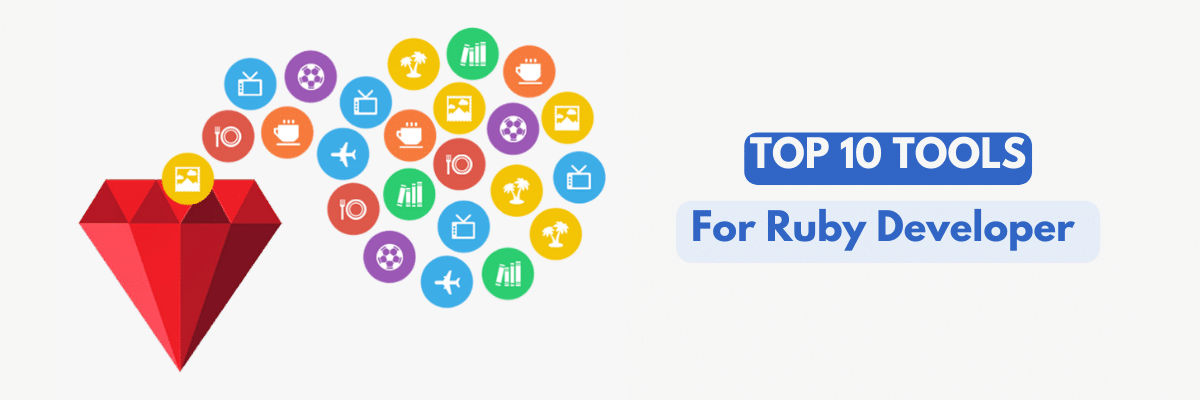Code Like a Pro: Top 10 Tools Every Ruby Developer Needs
Ruby is a high-level, object-oriented programming language that was created in the mid-1990s by Yukihiro “Matz” Matsumoto in Japan. It has become increasingly popular in recent years for its simplicity, readability, and flexibility. Ruby is a versatile programming language commonly used in computer science for web development, server-side scripting, and building desktop applications.
One of the key strengths of Ruby is its focus on developer productivity. Its clean and concise syntax makes it easy to write and read code, while its extensive library of “gems” allows developers to quickly add functionality and features to their projects.
If you’re a Ruby developer looking to take your coding skills to the next level and improve your productivity and efficiency while working on Ruby projects, then you’ve come to the right place!
In this blog post, we’ll explore the top 10 must-have tools that every Ruby developer needs to code like a pro. From powerful text editors and versatile terminal emulators to essential version control and package managers, these tools are the building blocks of any successful Ruby project.
So, let’s dive in and discover the top 10 tools every Ruby developer needs to know about!
Table of Content
- Ruby vs Other Popular Languages
- Top 10 Tools for Ruby Developers
- Ruby Community and Resources
- Final Thoughts
- Frequently Asked Questions
Ruby vs Other Popular Languages
Ruby is a popular programming language that has been around for more than two decades, but how does it compare to other popular programming languages in terms of features and benefits? Here are some of the significant differences and benefits of Ruby compared to other languages:
1. Language Syntax
Ruby’s syntax is elegant, concise, and readable, making it easier for developers to write code quickly and efficiently. This is in contrast to more verbose and complex syntaxes found in languages like Java and JavaScript.
2. Dynamic Typing
Ruby’s dynamic typing allows variables to hold any type of data, and the type of the variable is determined at runtime. This gives developers more flexibility when writing code. In contrast, developers must explicitly declare variables with a specific data type in Java and other statically typed languages.
3. Built-in Functions and Libraries
Ruby’s vast array of built-in functions and libraries make it easy to write code without having to reinvent the wheel. This is especially useful for developers who want to quickly create projects without worrying about building everything from scratch. While Python and JavaScript also have many built-in functions and libraries, Java has a more extensive range of third-party libraries.
4. Scalability
Ruby’s performance can suffer when dealing with large-scale applications, which can be a concern for developers working on complex projects. Contrastingly, developers often use Java and JavaScript for building large-scale applications due to their scalability.
Top 10 Tools for Ruby Developers
As a Ruby developer, having the right set of tools can make a significant difference in your productivity and efficiency. Here are the top 10 tools every Ruby developer should have in their toolkit:
Text Editors
Text editors are essential tools for any Ruby developer, as they allow you to write and edit code efficiently and effectively. There are many different text editors available, each with its unique features and capabilities.
In this section, we’ll take a closer look at two of the most popular text editors for Ruby developers:
1. Sublime Text
Sublime Text is a lightweight, fast, and powerful text editor that’s perfect for Ruby developers who want a simple yet powerful tool for writing code. It offers a range of features that make coding a breeze, including syntax highlighting, auto-completion, and multiple cursors.
With Sublime Text, you can customize your workflow with the help of various plugins, which can add new functionality and enhance your coding experience.
2. Visual Studio Code
The developers designed Visual Studio Code as a modern and feature-rich text editor that helps you write high-quality code quickly and easily. It comes with a host of built-in features and extensions that make it a top choice for top Ruby developers. These features include intelligent code completion, debugging tools, Git integration, and more.
Additionally, Visual Studio Code has a user-friendly interface that’s easy to navigate, making it a great choice for beginners and advanced users alike.
Terminal Emulators
Terminal emulators allow you to interact with your system’s command line interface and execute commands efficiently. They come with a range of features and customizations that can help you streamline your workflow and make it easier to manage your Ruby projects.
3. iTerm2
iTerm2, designed for macOS users, is a powerful and feature-rich terminal emulator. It offers a range of features that make it a top choice for Ruby developers, including split panes, advanced search, and a customizable user interface.
One of the convenient features of iTerm2 is the ability to save and restore your terminal sessions. This is a great time-saver and can help you pick up where you left off in your work.
4. Terminator
Terminator is an open-source terminal emulator that’s available for Linux users. It offers a range of features that can help you improve your productivity and efficiency, including multiple terminals in one window, custom layouts, and drag-and-drop support.
Terminator offers the option to create custom profiles for your terminals. This makes it easy to switch between different projects and configurations without having to set them up every time. This can save you valuable time and increase your productivity as a Ruby developer.
Version Control
Version control is a critical component of any software development project. It allows you to track changes to your code, collaborate with other developers, and revert to previous versions if necessary. Let’s take a closer look at two popular version control tools for Ruby developers.
5. Git
Git is a widely used distributed version control system. It is designed to handle small to large projects with speed and efficiency. As a Ruby developer, Git can help you keep track of your code changes. It also allows you to collaborate with other developers and maintain a history of your project.
With Git, you can create branches to work on different features, merge your changes with the main branch, and resolve any conflicts that arise during the development and testing process.
6. GitHub
GitHub is a web-based hosting service for Git repositories that provides a range of additional features and tools for Ruby developers. “With GitHub, you can create public or private repositories to host your projects. Collaborate with other developers using pull requests and issues, and use a range of project management tools to track your progress.
GitHub also offers a range of integrations with other tools and services, such as code editors and continuous integration systems.
Package Managers
In Ruby development, managing dependencies is crucial, and that’s where package managers come in handy. These tools make it easy to install, update, and remove software packages and libraries. There are two commonly used package managers for Ruby development.
7. Bundler
Bundler is a popular package manager for Ruby that allows you to specify and manage dependencies for your projects. With Bundler, you can easily install and manage gems, as well as specify which gems and versions are required for your project.
Bundler also helps ensure that all developers working on the project are using the same versions of gems, which can prevent conflicts and issues down the line.
8. RubyGems
The default package manager for Ruby is RubyGems, and developers use it to distribute and manage Ruby libraries and applications. With RubyGems, you can easily search for and install gems, as well as publish your gems to the RubyGems repository.
Also, You don’t need to install RubyGems separately as it comes included with Ruby.
Debugging Tools
You, as a Ruby developer, will likely come across bugs and errors in your code from time to time. But fear not! With some knowledge and the right debugging tools, you can quickly identify and fix those pesky issues. We’ll explore how Pry and Byebug tools can help you quickly and effectively troubleshoot issues in your Ruby code.
9. Pry
Pry is a powerful interactive shell that allows you to step through your code line by line, inspect variables and objects, and even modify your code on the fly. It’s a favorite among Ruby developers for its intuitive interface and extensive feature set.
With Pry, you can quickly get to the bottom of any bugs or errors in your code.
10. Byebug
Byebug, on the other hand, is a simple yet effective debugger that allows you to set breakpoints in your code and step through and test it at your own pace. It’s easy to use and provides helpful error messages and stack traces to help you pinpoint the source of any issues.
Byebug is a great tool for beginners and experienced developers alike and is a must-have in any Ruby developer’s toolkit.
Ruby Community and Resources
The Ruby community is one of the most active and supportive developer communities out there. If you’re a Ruby developer, you’re in luck because there are plenty of resources available to help you learn and grow in your career. Here are some of the top resources you can take advantage of as a Ruby developer:
1. Ruby Gems
Ruby Gems is a package manager for Ruby that allows developers to easily install, use, and manage third-party libraries and frameworks. With over 150,000 gems available, Ruby Gems is an essential tool for any Ruby developer.
2. Ruby on Rails
Developers build Ruby on Rails, a popular web application framework using Ruby. They design it to make building web applications faster and easier, and it has a large and active community of developers.
3. Ruby Weekly
Ruby Weekly is a popular email newsletter that provides weekly updates on the latest news, trends, and tips in the Ruby community. It’s a great way to stay up-to-date on what’s happening in the Ruby world.
4. Ruby Meetups
Ruby Meetups are local events where developers can meet and connect with other Ruby enthusiasts in their area. They’re a great way to network, learn new skills, and stay engaged with the Ruby community.
Final Thoughts
As a Ruby developer, having the right tools at your disposal can make all the difference in your coding workflow. From text editors to version control and package managers, we’ve covered a wide range of essential tools in this blog post. With these tools in your toolkit, you can enhance your productivity and efficiency, and take your coding skills to the next level.
The world of Ruby development is constantly evolving, and there are always new tools and techniques to explore. So, while we’ve highlighted the top 10 must-have tools for Ruby developers, don’t be afraid to continue your search for new and innovative tools and technologies that can help you write better code faster.
Whether you’re a beginner or an experienced developer, these tools can help you as a programmer to improve your coding workflow and boost your productivity. So go ahead and give them a try, and don’t forget to enjoy the process! Happy coding!”
Thank you for reading through to the end. You may also be interested in -‘Pros and Cons of Ruby Development’
Frequently Asked Questions
What is the job description for a Ruby developer?
A Ruby developer is responsible for writing clean, efficient, and maintainable code in the Ruby programming language. They may work on developing new applications or maintaining existing ones. They may collaborate with a team of other developers or stakeholders to understand project technical requirements and deliver solutions.
What do you call a ruby developer?
A company or team may refer to someone who specializes in Ruby development as a “Ruby developer.”However, companies may assign various job titles and responsibilities to Ruby developers, such as software engineer, software developer, or web developer, depending on the specific role and company.
What is the salary of a Ruby developer?
The salary of a Ruby developer can vary depending on factors such as experience level, location, and industry. However, as a profitable career option, Ruby developer salaries in India typically range from 2.0 to 12.5 Lakh with an average of 5.5 Lakh yearly.
What kind of projects can be developed using Ruby?
Ruby can be used for a wide variety of projects, including web development, mobile app development, desktop applications, game development, and automation scripts. Its flexibility and versatility make it a popular choice among developers.
What are some popular companies that use Ruby?
Some of the popular companies that use Ruby include Airbnb, GitHub, Shopify, Twitch, and SoundCloud. These companies use Ruby for their web development and back end development.
Can Ruby be used for web development?
Yes, the Ruby on Rails developer is commonly used for web development. Ruby on Rails, a popular web framework, is built on top of Ruby and is widely used for building web applications.
Is Ruby a good language for data analysis?
While Ruby is not typically used for data analysis, it does have some libraries and tools available for data manipulation and analysis, such as NMatrix, NArray, and SciRuby. However, other programming languages such as Python and R are more commonly used for data analysis.
What is the difference between Ruby and Ruby on Rails?
Developers build Ruby on Rails web applications using the Ruby programming language. Ruby on Rails provides a structure for building web applications and simplifies the development process by providing pre-built components and tools.





![What is Augmented Reality? | 11 Strategic Benefits of AR for Businesses [2023]](https://saaslyft.com/wp-content/uploads/2023/03/Untitled-design-37-768x309.png)



